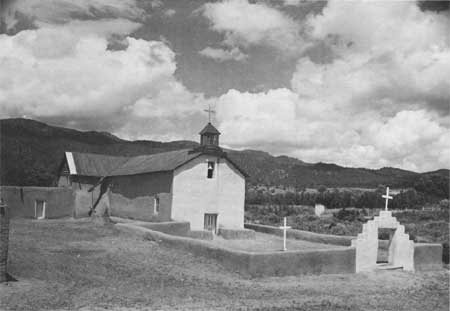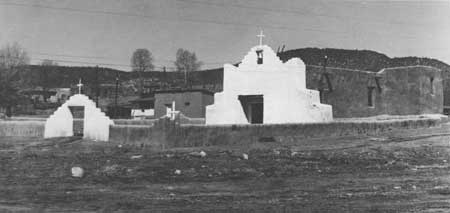

|
Picurís At the isolated mountain mission and pueblo of San Lorenzo de Picurís, where the Tiwa Indians were known for their coolness toward missionaries, an eager Fray Fernando Duque de Estrada kept himself busy making things. He did not stay long, no more than a year or two, and then apparently he left New Mexico. A scrupulous sort, he noted down in the Picurís inventory book all his improvements and accessions during the period August 13, 1746, to August 13, 1747. His entry appeared to be a model of precision, and of self-congratulation. "First, the sanctuary with three steps and its wooden railings," which he implied that he had caused to be built from the foundations up. The entire church, and almost everything else within reach, was newly whitewashed. He had leveled the church floor, repacked the roof with dirt, built a crenelated parapet all the way round, and raised up the belfry. He had restored and refilled with earth the whole cemetery and set three large steps up to the entrance. Inside he had provided all sorts of furnishings, from tabernacle to confessional to wooden candelabra. The convento he had remodeled throughout, beginning with the minister's cell, which received more dirt on the roof, a crenelated parapet with new canales 1/4 vara wide by 2 varas long (about 8 by 66 inches), as well as whitewash, a cookoven with grate, and a bed. The stairway, which had collapsed in the middle, was rebuilt. A new adobe stable went up with two stalls and "its battlements of hefty beams," a large, roofed kitchen, and a fence of poles around the ample garden. There were doors and gates and grain bins and benches, and a thousand adobes extra, as well as "an upper room for privies, roofed, with its two-seat box." A year later another friar made a brief entry on the next page. Everything to do with the convento listed by his predecessor, he said, came down to the fact that "the earlier rooms, with kitchen, oven, doors, and windows that were below, Father Duque de Estrada moved above, with the result that below there is nothing now but the ruins of what there was before." The next man agreed. There was in 1749 "nothing at this mission but disrepair and misery." [1] Unfortunately Father Domínguez had no chance in 1776 to describe the church and convento that Duque de Estrada claimed to have renovated, and thereby to condemn or vindicate the earlier friar. That mission complex had stood across a little arroyo a hundred yards east of the pueblo's lower and newer plaza, in a rather exposed and lonely position. Picurís, like Pecos and Taos, had long maintained relations with the nomadic peoples of mountains and plains, the Jicarilla Apaches, Utes, and Comanches. They enjoyed the bounty of buffalo hunting, trade, and ceremonial kinship, and as a price they suffered involvement in the nomads' wars. By the 1760s the Comanches, who had pushed Apaches and Utes back on New Mexico, were striking deep into the province. When a large war party rode down on Picurís in 1769, the people watched from the pueblo as the raiders thoroughly sacked the outlying mission. Fray Andrés de Claramonte "escaped by a miracle." To deny them the pleasure of a second such outrage, Governor Pedro Fermín de Mendinueta ordered what was left leveled to the ground. A new church must be built right against the pueblo. When Domínguez arrived April 1776 its walls stood about 8 feet high. [2]
It would be small, a single-nave plan, 19 by 66 feet, facing south. Father Claramonte, a missionary of whom Domínguez warmly approved, had carried the job this far. Before the year was out, Fray Sebastián Ángel Fernández, a scoundrel in Domínguez's book, arranged for its completion. He entered into a civil contract with Alcalde mayor Salvador García de Noriega of Santa Cruz that bound the latter to construct the church, now with transept, door, two windows to the east, choir loft, corbels, and round beams, plus a three-room dwelling, a sort of token convento, joining church and pueblo. García guaranteed completion within eighteen months. His payment—all of it, alleged Domínguez, profits from Fernández's illicit trading ventures—came to "12 cows, 12 yearling calves, 25 ewes with a stud ram, a fine she-mule, 100 fanegas of maize and wheat, 100 pounds of chocolate." [3] Father Pereyro in 1808 called the result "ordinary." He said that the little convento had been "rebuilt" in 1780 and that a main altar screen had been paid for by Fray Francisco Martín Bueno who served his time here between 1785 and 1787. Extremely critical of the sloppy administration of Fray Juan Bruno González (1816-24), the irate Visitor Guevara did not even mention the church. He did list in 1818 the altar screen above the main altar with its eight oil-painted images. By the first visitation of Bishop Zubiría in 1833, when Fray José de Castro looked in on Picurís once in a while from Santa Clara and San Juan, it was the desolation not of the building but of its contents that appalled the prelate. "It lacks, among many other things, even a legitimate altar stone, for there is none there with sepulcher and relics." [4] Later travelers were impressed by the way the people of Picurís, who had no priest of their own, took care of their church. "Another half mile over a very rocky hill, very steep but not of any great height, our ambulance jumping from boulder to boulder," came John Gregory Bourke in 1881. The pueblo in general, had "a slouchy, down in the heel look," he thought.
"It is one of the sights of Picurís," allowed Judge Prince a generation later, "to watch the stalwart blows given to this ancient bell in order to bring forth the greatest volume of sound." According to him, the people of the pueblo and the sacristan—for decades the venerable Antonio Vargas and in 1915 his son-in-law Santiago Martín—kept the walls of the church "in such perfect repair that the first impression received is that it is comparatively modern." For several decades of the twentieth century, the church at Picurís wore a pitched tin roof. Restored to traditional profile in the late 1960s, "torn down nearly to ground level and rebuilt by the pueblo over a two year period," it looks today much as it did in 1778 newly laid up with dirty profits by a pastor Domínguez accused of trading when he should have been caring in poverty for the souls of his flock. [6] Copyright © 1980 by the University of New Mexico Press. All rights reserved. Material from this edition published for the Cultural Properties Review Committee by the University of New Mexico Press may not be reproduced in any manner without the written consent of the author and the University of New Mexico Press. | ||||||
 Top Top
|
| ||||||




